No one innovates more than their relationships allow: The case of small farmers
DOI:
https://doi.org/10.19136/era.a10nNEIII.3718Keywords:
social network analysis, productive communication, sustainable agricultural innovations, extension services, learning linkagesAbstract
Countering the confrontation between productive systems established by humans for food production and natural systems that support life and the climate requires the adoption of sustainable innovations, oriented towards responsible production (SDG 12) and reduction of biodiversity loss (SDG 15). This article analyzes the role of social relations in the adoption of sustainable agricultural innovations among smallholder maize farmers in the framework of a national extension process. We used paired data from 14 770 smallholders, from 2017 and 2018, in almost 50 % of Mexico's federal entities. The data were analyzed using social network indicators and a logit model. The findings show that the probability (P < 0.01) of adopting innovations from one year to the next increases if producers develop relationships with better connected actors in the network (change in radiality), expand the number of clients and have greater planted area. Producers with greater change in radiality establish patterns of adoption of sustainable innovations that allow them to maintain or improve their yields, decreasing land degradation and biodiversity loss. This implies that learning linkages are more important than other variables such as age, schooling, or farmer experience in promoting changes in innovation levels. It is advisable to reconfigure extension models to promote learning linkages and the generation of social capital.
Downloads
Downloads
Published
Issue
Section
License
Copyright (c) 2023 Ecosistemas y Recursos Agropecuarios

This work is licensed under a Creative Commons Attribution-NonCommercial-ShareAlike 4.0 International License.
Aviso de copyright
Los autores que se envían a esta revista aceptan los siguientes términos:
una. Los autores conservan los derechos de autor y garantizan a la revista el derecho a ser la primera publicación del trabajo con una licencia de atribución de Creative Commons que permite a otros compartir el trabajo con un reconocimiento de la autoría del trabajo y la publicación inicial en esta revista.
B. Los autores pueden establecer acuerdos complementarios separados para la distribución no exclusiva de la versión del trabajo publicado en la revista (por ejemplo, en un repositorio institucional o publicarlo en un libro), con un reconocimiento de su publicación inicial en esta revista.
C. Se permite y se anima a los autores a difundir su trabajo electrónicamente (por ejemplo, en repositorios institucionales o en su propio sitio web) antes y durante el proceso de envío, ya que puede conducir a intercambios productivos, así como a una cita más temprana y más extensa del trabajo publicado. (Consulte El efecto del acceso abierto).


